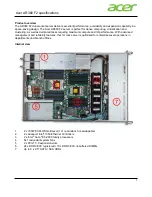
C h a p t e r 6
Problem Solving
Contents
Resetting the System............................................................... 1
Troubleshooting Checklists ...................................................... 2
Initial System Startup ......................................................... 2
Running New Application Software ...................................... 4
After System Has Been Running Correctly ........................... 5
Additional Troubleshooting Procedures ..................................... 6
Error Checking ................................................................... 6
Troubleshooting Guide ....................................................... 6
Specific Problems and Corrective Actions ............................... 10
Power LED Does Not Light ................................................ 10
System Cooling Fans Do Not Rotate .................................. 11
No Characters Appear On Screen...................................... 12
Characters are Distorted or Incorrect................................. 13
Incorrect Or No Beep Code ............................................... 13
Floppy Disk Drive Activity LED Does Not Light ................... 14
Hard Disk Drive Activity LED Does Not Light ...................... 15
Problems with Application Software ................................... 16
BIOS User’s Information ........................................................ 17
Error and Status Messages ............................................... 17
Messages and Beep Codes ............................................... 20
System and Disk Status LED User’s Information ...................... 24
Summary of Contents for MT2200
Page 1: ... Server MT2200 U s e r s G u i d e ...
Page 2: ...xxx ...
Page 3: ... Server MT2200 U s e r s G u i d e ...
Page 6: ... xxx ...
Page 8: ...Bill Graham ...
Page 10: ...Bill Graham ...
Page 11: ...Chapter 1 Introduction Contents Organization 1 Notational Conventions 3 ...
Page 12: ...Bill Graham ...
Page 18: ...xxx ...
Page 46: ...xxx ...
Page 54: ...1231231 Billy Graham ...
Page 88: ...4 34 Configuring Your System ...
Page 90: ...xxxxx ...
Page 107: ...5 17 Upgrades and Options Figure 5 7 Inserting Memory DIMMs A B C J20 J19 J18 J17 ...
Page 134: ...5 44 Upgrades and Options Figure 5 22 Removing the Front Fan modules ...
Page 136: ...5 46 Upgrades and Options ...
Page 138: ...dfgdfg ...
Page 166: ...Bill GrahamBill Graham ...
Page 175: ...Appendix B Memory Configurations Contents Memory DIMM Configurations 1 ...
Page 176: ...Bill Grahamaerrterterter ...
Page 180: ...rtyrtyrtyrtyry ...
Page 190: ...8 Glossary ...
Page 191: ...xx ...
Page 192: ... 101907 01 ...
















































